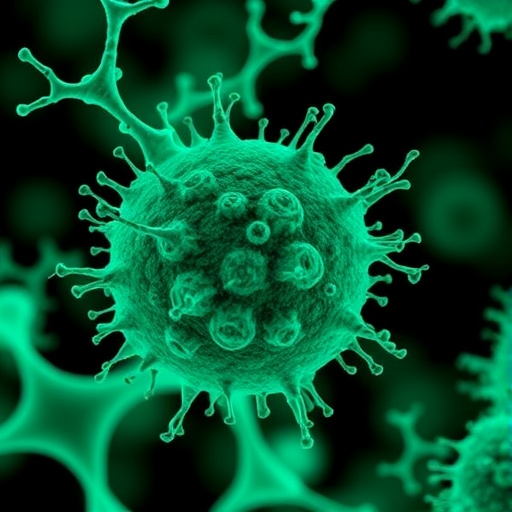Antimicrobial resistance is one of the most pressing global health challenges of our time. The proliferation of biofilm-associated infections underscores the critical need for novel therapeutic strategies that can effectively target these resilient microbial communities. In groundbreaking research led by Sankaran and his team, a new class of compounds known as antimicrobial quinoline triazoles has emerged, showing promising potential against these challenging infections.
This research specifically focuses on the synthesis and characterization of quinoline triazole derivatives, which have been identified for their ability to inhibit pathogenic bacteria that form biofilms. Biofilms, which are clusters of microorganisms encased in a protective layer, often exhibit decreased susceptibility to the immune response and traditional antibiotics, leading to persistent infections. The study employs advanced techniques including molecular docking and dynamic simulations to provide a detailed understanding of these interactions on a molecular level.
The synthesis of quinoline triazoles involves several intricate steps, beginning with the creation of a quinoline scaffold, a structure known for its biological activity. The research team then introduces triazole moieties through a series of chemical reactions, laying the foundation for compounds with enhanced antimicrobial properties. By optimizing these reactions, they were able to produce a library of diverse quinoline triazole derivatives, each potentially having unique bioactivity profiles.
In addition to synthesis, the study employs docking studies to predict how well these newly synthesized compounds can bind to critical targets within microbial cells. Docking simulations are vital as they provide insights into the interaction between the quinoline triazoles and specific microbial proteins, highlighting the structural attributes that facilitate binding and inhibition. Through this computational approach, researchers aim to identify candidates with the highest likelihood of success in disrupting bacterial functions.
Dynamic simulation studies further augment the findings from docking. These simulations allow researchers to observe the behavior of the quinoline triazoles over time within a biological environment, providing a real-time view of how these compounds interact with bacterial cells. Such studies reveal not only the stability of the quinoline triazole interactions but also the potential for resistance development in microbial populations.
The results of this research have significant implications for the treatment of biofilm-associated infections, which are notoriously difficult to eradicate. By targeting the biofilm structure directly, these quinoline triazoles can potentially reduce the persistence of infections caused by multi-drug-resistant organisms. Such an approach may also pave the way for combination therapies that use quinoline triazoles alongside existing antibiotics, enhancing their efficacy and overcoming resistance mechanisms.
Moreover, this research highlights the importance of an interdisciplinary approach in addressing public health challenges. By combining synthetic chemistry, molecular biology, computational modeling, and pharmacology, the study exemplifies how collaboration across various scientific domains can lead to innovative solutions. This comprehensive methodology is crucial in the quest to expedite the discovery of new antimicrobials in a landscape where traditional drug development avenues are becoming increasingly limited.
As antibiotic resistance rises, the urgency for rapid translation of research findings into clinical applications becomes paramount. The researchers emphasize the need for further preclinical studies that will validate the in vitro results demonstrated in this study. Once efficacy and safety are confirmed through these additional studies, the path toward clinical trials can begin, moving these promising quinoline triazole compounds closer to real-world applications.
Public health authorities will also need to consider how such novel antimicrobial strategies can be integrated into existing treatment frameworks. This not only demands adherence to regulatory standards but also requires strategic investment in antimicrobial stewardship programs. Such initiatives are essential to ensure the responsible use of new therapies, thereby preserving their efficacy over time.
In summary, the work by Sankaran, Kaliyamoorthy, and Alagumuthu on quinoline triazoles signifies a promising shift in the fight against biofilm-associated infections. By synthesizing new chemical entities and characterizing their interactions with bacteria on a molecular level, this research lays the groundwork for new therapeutic options to combat the growing threat of antibiotic resistance. The potential of these compounds to disrupt established resistance patterns offers hope for more effective treatments, calling for continued exploration and investment in this crucial area of antimicrobial research.
While the journey from laboratory discovery to clinical application is long, the advancements made in this study provide invaluable insights that can catalyze further innovation within the field. By nurturing the development of such compounds and pursuing their potential integration into therapeutic regimens, researchers can contribute meaningfully to global health and the broader challenge of antimicrobial resistance.
Subject of Research: Antimicrobial quinoline triazoles and their effects on biofilm-associated infections.
Article Title: Antimicrobial quinoline triazoles: synthesis, docking, and dynamic simulation studies against biofilm-associated infections.
Article References:
Sankaran, M., Kaliyamoorthy, K. & Alagumuthu, M. Antimicrobial quinoline triazoles: synthesis, docking, and dynamic simulation studies against biofilm-associated infections.
Mol Divers (2025). https://doi.org/10.1007/s11030-025-11324-1
Image Credits: AI Generated
DOI:
Keywords: Antimicrobial resistance, quinoline triazoles, biofilm, molecular docking, dynamic simulations, synthetic chemistry, clinical applications, drug development, multi-drug resistance, public health.
Tags: advanced drug developmentantimicrobial properties of triazolesantimicrobial resistance strategiesbiofilm inhibition mechanismsbiofilm-associated infectionschemical reaction optimizationmolecular docking techniquesnovel antimicrobial compoundspathogenic bacteria targetingpersistent infection treatment strategiesquinoline triazole derivativessynthesis of quinoline scaffolds





